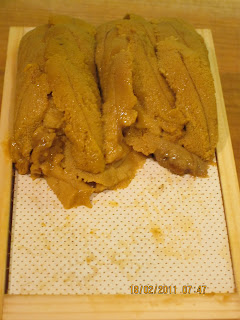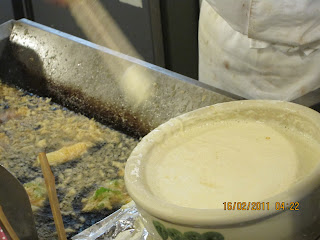Kakizaki San. Sushi Expert Chef. Formerly of Hyatt. Opened several Japanese restaurant for Hyatt Hotel in Asia.
The treasure chest. His inventory for the night. Just good enough for 8 to 10 people.
The Otoro - (Bluefin Tuna belly) the most prized of all tuna. This batch was never frozen.
Fresh creamy "uni" or sea urchin roe. Not runny, not smelly and not at all fishy. Heavenly!!
The other "uni". I prefer this one. It has a slightly more pronounced urchin taste. I will grab any opportunity to get another taste of this delicacy. It was my highlight for the night.
This is it!! The best meal I ever had in my whole life!! Sushi at it's best is the pinnacle of all meals!!! Especially done by a "master" sushi chef. Not just any chef who knows how to ball rice, puts a green paste and places a raw fish on top.
This so unlike the sushi that we've grown accustomed to. This was no Dynamite, Rock and Roll, Spider fucking sushi. No fucking mayo and mango allowed. Take that shit away please.
This is what it's all about. Sushi in its most basic and simplest form.
A great sushi chef starts with his ingredients. The freshest and the best ingredients of that day. He knows the season when a particular seafood is at its best. He knows the the best time and place in which a certain ingredients is at its finest. He establishes a relationship with the supplier to give him the best. That intimate chef-fishmonger relationship takes time. It takes a lot of time to gain the trust of the purveyor for him to give you the best. The purveyor should be assured that you know what your doing and will be skilled enough to do the best for his goods.
Each ingredient (pardon my cliche) tastes like the sea. Every bite is like an explosion of flavors reminiscent of the sea. Each particular ingredient has their own unique taste and flavor but one thing that is consistent is the fresh "sea" taste. I honestly cant put in words. It's just that fresh raw seafood is amazing.
His attention to detail starts from his ingredients, the type of rice, the doneness of the rice, which vinegar is best, the kind of soy sauce and finally the use of fresh as in grated wasabi.
Our host, Marc Handl, Hotel Manager for Tokyo Peninsula, is a sushi expert. Having lived in Tokyo almost all his life, he knows his sushi. He knows the most passionate sushi chefs. He taught me that a great sushi chef pays attention to every aspect of the sushi. The ingredients and the season in which the seafood is at its best. The rice, how its cooked and its doneness. The vinegar used. The vinegar they use for the rice is sometimes even more expensive than wine. Same with the soy sauce and the nori. Attention to detail and an eye for quality should be a sushi chef trait.
I learned that great sushi is so unlike what we have here in Manila or probably anywhere else. Uncomparable.
Food Truths:
1. Seafood used for that meal should never have been frozen. It should be served hours after it has been caught or harvested. Expert food handling is a must.
2. Sushi rice is kept at room temperature.
3.It should be bite sized and fit in ones mouth easily.
4. Soy sauce should only be a hint. It shouldn't mask the great flavor of the sushi.
5.Fresh grated wasabi is still the standard. It's not even in the same planet as the powder and paste variety we get.
Sushi might be simple but when done by a master sushi chef it becomes an amazing sometimes surreal food experience.
Unforgettable, awesome and amazing!!!































